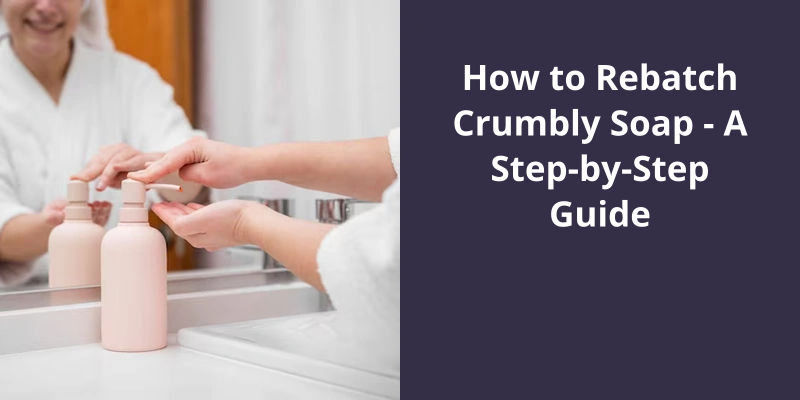To rebatch crumbly soap, you first need to grate the soap into smaller pieces, then place them in a heat-proof bowl. To melt the soap, you can use a double boiler method, where the bowl is placed over a pot of gently simmering water. Stir the soap regularly to help it melt evenly. Now, add a small amount of liquid like water, milk, or tea, taking care not to make the soap mixture too runny. You could also infuse herbs or essential oils at this stage if wanted. Once the soap is completely melted and evenly mixed, pour it into soap molds and let it cool and harden. After hardening, simply pop the soap out of the molds, and allow it to cure for a few weeks before use.

Can I Add Oil to Rebatch Soap?
Soapmaking is a fun and rewarding hobby, but even the most experienced soapmakers can run into a problem or two. If you find yourself with a batch of soap that’s turned out too oily or too lye-heavy, you may be wondering how to salvage it. One option is to rebatch the soap, which involves heating it up with some liquid and then pouring it back into a mold to reset. But can you add oil to rebatch soap? The answer is yes, but there are some important things to keep in mind.
To begin the rebatching process, youll need to grate your soap into small pieces and mix it with a liquid. This could be water, milk, or even an oil like coconut or olive oil. The liquid will help to dissolve the soap and create a smooth, consistent texture. As you stir the mixture together, you can also add any additional oils or ingredients that you want to include. This is where you can add the oil that you left out in the original batch, if necessary.
It’s best to start with a small amount of oil and gradually increase it as needed. You can always add more oil later if you find that the soap is still too dry or crumbly.
Another factor to consider when rebatching soap is the quality of the oils that youre using. If youre adding a lot of low-quality or rancid oils to the mixture, the soap may not turn out as well as youd like.
Crafting soap can be a fun and rewarding process, especially if you’re focused on creating eco-friendly and sustainable products. Whether you’re a seasoned soap maker or just starting out, rebatch soap provides an exciting way to reuse scrap soap and turn it into something new. While the process itself is fairly straightforward, achieving the perfect, smooth texture can be a little tricky. In the following sections, we’ll explore some tips and tricks for perfecting your rebatch soap technique.
How Do You Make Rebatch Soap Smooth?
The key to making rebatch soap smooth lies in both the technique and the base soap used. If your soap is too hard, try soaking shavings in milk or coconut milk to make it softer.
When melting your soap, it’s important to be patient and not rush the process. If you heat the soap too quickly or too hot, it can burn and ruin the final product. Instead, melt the soap slowly on low heat, stirring occasionally to ensure it melts evenly and doesn’t burn.
These can help to soften the soap and make it easier to work with. Be careful not to overdo it, however, as too much oil can affect the consistency of the final soap.
After melting the soap, blend it on high speed until it becomes smooth and uniform. This will help to break up any clumps or chunks and distribute the melted soap evenly.
Finally, remember that making rebatch soap is a trial and error process. It may take a few attempts to get the consistency and texture just right, so don’t be discouraged if your first batch doesn’t turn out perfectly. Keep experimenting and trying new techniques until you find the method that works best for you.
Tips for Adding Color and Fragrance to Rebatch Soap
Here are some suggestions to naturally add color and fragrance to rebatch soap:
1. Add natural coloring agents like spirulina powder, turmeric powder, beetroot powder, cocoa powder, or activated charcoal powder.
2. Use essential oils or natural fragrances like dried lavender, rose petals, or chamomile to infuse pleasant aroma.
3. Consider incorporating natural extracts like vanilla, grapefruit, peppermint, or lemon.
4. You can also add some natural clays like French green clay or pink kaolin clay to enhance the beauty of the soap.
By using these natural ingredients, you can create unique and eco-friendly soap that’s a personal touch.
While rebatching may not be the most common soapmaking technique, it can be incredibly useful for repurposing old soap or creating unique blends. However, if you prefer to start from scratch, cold process soapmaking is a great place to start! Here’s a simple guide to making your own soap using this method.
Can You Rebatch Old Soap?
Rebatching is a popular soapmaking technique used by hobbyists and artisan soapmakers. This process involves taking commercially purchased or previously made soap (known as a soap base) and shredding or dicing it finely. The soap shreds are then mixed with a liquid, which causes them to begin dissolving. This mixture is then heated and stirred until it reaches the desired consistency, at which point it’s poured into molds to cool and set.
One of the main benefits of rebatching soap is that it allows soapmakers to reuse old or imperfect soap that would otherwise be discarded. It can also be a way to salvage a batch of soap that didn’t turn out quite right the first time around.
The main difference between the two is that French milling involves grating and reprocessing the soap base multiple times to ensure a consistent texture and remove impurities. Rebatching, on the other hand, is a simpler process that can be done at home with minimal equipment.
Once the rebatched soap has cooled and set in molds, it can be cut into bars and used like any other soap. Some soapmakers prefer the texture and scent of rebatched soap over other types of soap, since it allows for more customization and experimentation.
Now that you’ve a basic understanding of the rebatching soap process, it’s important to address a common question: how much oil should be added to the soap? In this article, we’ll delve into some tips and tricks for adding oil to your rebatch soap and creating a customised product that suits your preferences. But before we tackle that, let’s explore some other important factors to consider when rebatching soap.
How Much Oil Do I Add to Rebatch Soap?
When it comes to rebatching soap, there are a few things to keep in mind. One of the most common questions that arises when trying to rebatch soap is how much oil to add. The truth is that there’s no one-size-fits-all answer to this question, as the amount of oil youll need will depend on the type of soap youre working with. Generally, youll need to add a small amount of oil to the soap base to help it melt down and emulsify.
For example, when using plastic molds, it’s a good idea to spray or rub the inside of the mold with vegetable oil to prevent the soap from sticking. This will make it much easier to remove the soap from the mold once it’s hardened.
Adding these oils can help to enhance the scent of the soap and bring out it’s natural properties. When adding essential oils or fragrance oils, it’s generally recommended to add up to 2 tsp. or 10ml per pound of soap base.
Finally, when adding colorants to your rebatch soap, it’s important to choose the right type of colorant and use it in the proper amount. For example, some colorants may require more or less to achieve the desired effect. As a general rule, youll want to start with a small amount and add more as needed until you get the color youre looking for.
By following these tips and guidelines, youll be able to create beautiful and fragrant soaps that are perfect for your needs. Whether youre an experienced soap maker or just getting started, these tips will help you achieve success in your rebatching endeavors.
Now that we’ve covered the basic steps of making homemade soap, it’s time to dive deeper into the process and explore the various types of ingredients and techniques used to create unique and personalized soap bars. Whether you’re a beginner or an experienced soap maker, there’s always something new to discover and experiment with. So, grab your apron and let’s get started on your soap making journey!
How Do I Start Making Homemade Soap?
Making homemade soap can be an extremely rewarding and satisfying hobby for those who enjoy creating their handmade personal care products. Starting the process of making soap at home is relatively simple, although it does require some knowledge and basic equipment. One of the most important things to consider when beginning the process is the safety of handling lye, which can be dangerous if not handled properly.
The initial step in the process is to mix water and lye, which is also known as the alkaline solution. It’s important to take extreme caution while handling lye, as it can cause chemical burns and irritations. After mixing the lye and water, let the solution sit aside to cool. Meanwhile, melt the oils and let them cool down, as well. Once both the alkaline solution and melted oils have cooled down to a similar temperature, they can be blended together using a stick blender, creating the soap batter.
After blending the oils and alkaline solution together, it’s time to pour the soap batter into the mold and let it harden for a day or two. Once the soap has set, remove it from the mold and cut it into bars. At this point, the soap must cure for two to three weeks before it’s ready for use. Curing allows the soap to evaporate excess water and harden, making it last longer and more effective.
Tips and Tricks for Scenting Homemade Soap
- Use high-quality essential oils or fragrance oils.
- Add the scent to the soap mixture after it’s cooled slightly, but is still thin enough to stir easily.
- Measure the fragrance carefully to avoid overpowering or underwhelming the scent.
- Consider using a scent calculator to determine the appropriate amount of fragrance oil to add.
- Incorporate any colorants or other additives into the soap mixture before adding the fragrance.
- Experiment with different scent combinations to create unique and appealing soap scents.
- Avoid using too much fragrance as it can cause skin irritation or affect the soap’s performance.
- Allow the soap to cure for at least several weeks to ensure the fragrance has fully developed.
Conclusion
In conclusion, rebatching crumbly soap can be a simple process with a few key steps. By carefully weighing the soap and adding water, it’s possible to bring the soap back to it’s natural texture. The baking process, at a low temperature, is crucial in ensuring that the soap is well blended and thoroughly cured. Adding extra ingredients, such as essential oils, can give the soap an added fragrance or benefit for the skin. Allowing the soap to cure for a few weeks will help it to harden and be ready for use.





